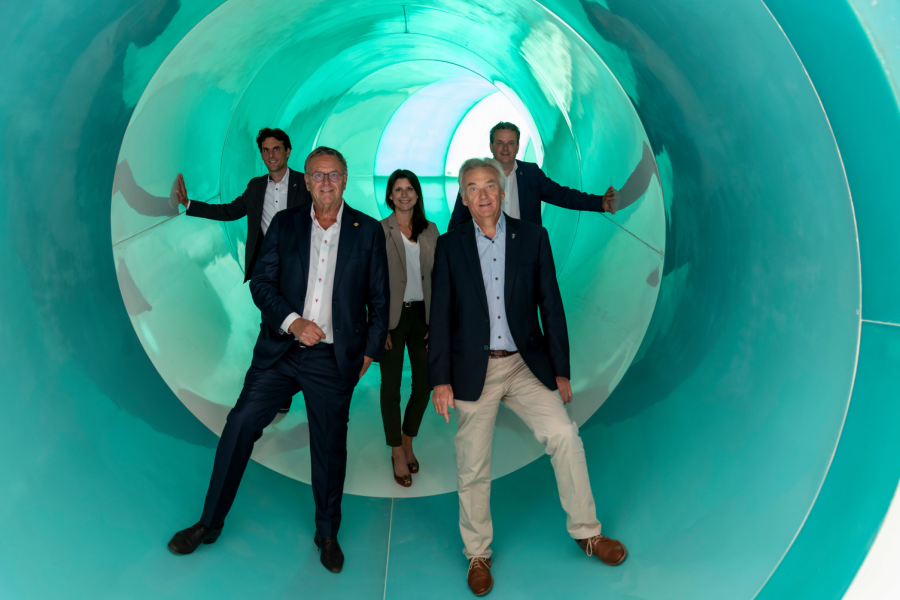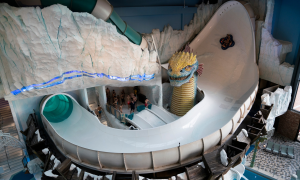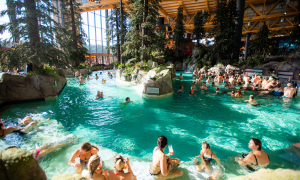Inside Rulantica, Europa-Park’s Epic New Indoor Water Park
Roland Mack will always remember his first test ride at Rulantica.
Days before the indoor water park on the edge of Germany’s Black Forest opened, the 70-year-old founder of Europa-Park stepped inside the starting pod of “Dugdrob and Vildfål,” Rulantica’s pair of vertical-start water slides. Standing with his ankles crossed on the slide’s trap door, he folded his arms over his chest in anticipation of dropping at an 80-degree angle.
“When I tested this slide, my adrenaline level was maxed out,” Roland recalls.
He quickly lost his breath when his 8-year-old grandson, Paul Mack, sneakily working in tandem with the slide operator unexpectedly opened the slide’s trap door, sending his grandfather plunging.
“No countdown or mental preparation for me! I saw the floor disappear immediately,” Roland says.
So, was Paul scolded following the inaugural ride? Just the opposite, as his grandfather lovingly remembers the event as “a fantastic experience with lots of fun.”
The bliss of that initial ride represents the largest investment he has made to date—and the completion of a vision that began in 1996 for a second gate at Europa-Park.
Roland and members of the Mack family gave Funworld an exclusive look at the three decades of research and design, along with an insiders-look at key learnings made during the first 100 days of opening, before Rulantica shuttered in precaution of the global coronavirus pandemic.
Planning for a Second Gate
Rising from former farmland, the Nordic-themed Rulantica in Rust, Germany, is a next-generation indoor water park. With its 17 water slides, wave pool, inner-tube rivers, outdoor pool area, unique food and beverage (F&B) offerings, and emphasis on guest service, Rulantica is an accomplishment in art, architecture, and adrenaline. Situated just southeast of Europa-Park, the theme park Roland opened together with his father, the late Franz Mack, in 1975 celebrating nations across Europe, Rulantica is the result of a quarter-century of planning.

“That was quite a process. We took our time to determine the concept of a second gate,” he tells Funworld.
As the process began, one of the first steps he took was to survey Europa-Park guests as to what kind of future development they would enjoy. A water attraction continued to bubble up in the research as a popular addition.
“It was a quite long and difficult discussion to determine whether we should build an indoor or an outdoor water park,” Roland says. “In the end, we decided to go with an indoor option for phase one, which would be independent of weather conditions and thus, allow us to operate the water park year-round.”
Guest feedback, along with a feasibility study, became the “two important pillars” referred to time and time again when planning Rulantica. With the research in hand, Roland and his team packed their bags and began visiting other water parks around the world.
“We not only could see and experience the attractions, but we also were able to exchange our thoughts with water park owners and operators,” he says of the globetrotting expeditions. Water parks in the United States resort town of Wisconsin Dells, Wisconsin; Aquatica by SeaWorld, Disney’s Blizzard Beach, and Universal’s Volcano Bay in Orlando, Florida; the Chimelong water park in China; Siam Park in Tenerife, Canary Islands, Spain; Aquaventure at Atlantis in Dubai, United Arab Emirates (UAE); and Yas Waterworld in Abu Dhabi, UAE, all became locations where the team performed site surveys. Back in Germany, Tropical Islands in Krausnick and Therme Erding in Erding both welcomed them.
“At all properties we visited, the doors were wide open, and we had an open exchange with plenty of insight into the water park industry,” he says of the friendly nature of fellow owners and operators.
Developing a World All its Own
With key learnings collected from around the world, the Mack family began developing a story for its own indoor water park early in the design process—a roadmap of sorts, that would guide its design.
“We learned quite a long time ago that visitors very much enjoy experiencing fully themed attractions that offer an elaborate story,” says Michael Mack, managing partner of Europa-Park. “During the past few years, we have put more and more focus on storytelling.”
When looking at themes, Michael turned to the European landscape and climate for inspiration.
“We did not want to be another tropical paradise,” he says. With palm trees banished, and a location selected next to the new four-star Superior Hotel Krønasår, The Museum Hotel—Europa-Park’s sixth hotel, reminiscent of a Scandinavian harbor—a Nordic theme for the water world prevailed.
“Inside, the guests find an elaborately equipped museum-themed hotel, with the adjacent water park being an exhibition space for the lost island of Rulantica,” explains Thomas Mack, managing partner of Europa-Park.
To arrive on a name for the new park, Michael worked with brand specialist Manfred Gotta to develop a title that previously did not exist in the lexicon.
“On the one hand, the name is completely new,” he says. “On the other hand, the name reflects the Nordic theming of our water world.”
The name Rulantica was vetted with test groups and found to work well in multiple European languages and internationally.
Generating publicity for the new attraction began with construction. The Mack family launched an online platform to allow users the ability to explore Rulantica in 3D, collaborated with publishing house Coppenrath to develop a book series, created an original musical score, and even built a dark ride that doubles as a preview center for guests visiting Europa-Park.
“Through these offers, we were able to prepare our guests that Rulantica would be far more than a swimming pool with some slides, and create a high level of anticipation,” Michael says.
When Rulantica opened on Nov. 28, 2019, guests already knew what to expect, thanks in part to a new character developed for the park. Named Snorri, the cute six-armed octopus—partly inspired by the features of Ed Euromaus of Europa-Park—had already become a spokesperson of sorts.
“We would never have dreamed of Snorri becoming such a success in such a short time,” he says.

Designing from the Inside Out
With the storyline set, the Mack Family, and the design team at MackSolutions, along with insight in master planning provided by PGAV Destinations in St. Louis, Missouri, began planning what attractions and amenities would populate the indoor water park.
“It was a wonderful and rewarding challenge to bring the unique design concept to life,” says Ann-Kathrin Mack, architect and Roland Mack´s daughter.
First and foremost: which water slides to incorporate. The team invested a great deal of effort into the selection process, relying upon 45 years of key learnings found next door.
“At Europa-Park, the rides are at the center of our visitors’ attention,” Roland says.
Germany is a nation known for high quality, tough standards, and very defined rules and regulations, explains Chip Cleary, senior consultant to Europa-Park.
“Based on that, we looked for vendors with EU experience and companies that could conform to all the rules and regulations,” says Cleary, who assisted in Rulantica’s planning and development. “We really had a long process of checklists to get through before we picked the final vendors.” The equipment selection and permit process with the aid of PBR Architecture took more than two years from beginning to end.
“While that may sound extreme to many, it allowed us the time to create and execute really big dreams,” Cleary says.
Rulantica’s foundation stone laying ceremony took place in September 2017, while the topping-off ceremony was held in December 2018.
The Nordic theme inside Rulantica’s shell-shaped, 32,600-square-meter hall is home to 25 attractions in nine settings that include Scandinavian landscapes and mystical scenery.
Bathers in “Snorri’s Saga” lazy river float into a cave, complete with ice formations reminiscent of those found on the underside of an iceberg. The “Trølldal” children’s area is inhabited by trolls—the native inhabitants of the island of Rulantica (as the story goes). Several of “Vinterhal’s” water slides send visitors past a giant sea snake named Svalgur. The “Surf Fjørd” wave pool serves as a central anchor to the indoor space, planned in part by Germany’s PBR Architecture.
Outside, the “Frigg Tempel” pool is joined by the heated “Vildstrøm” rapids river. Halfway through, the river splits apart and riders must choose to navigate a right or left tributary. (Beware: one direction features steep slopes.)
“The combination of an ideal layout and highly themed areas is the key to Rulantica being absolutely special and unique,” says Ann-Kathrin.
Operationally Speaking
Before arriving, Rulantica guests must first make a reservation via an online ticketing system. Each day, the park sells a limited number of day tickets and evening tickets. Traditionally, the park opens at 10 a.m. and closes at 10 p.m., giving Europa-Park guests an additional entertainment option after the theme park closes. An enclosed skybridge connects the indoor water park to Hotel Krønasår. Walk-up guests are welcome if the daily capacity of up to 5,000 guests is not yet met.
“This online platform serves great as a tool for controlling our capacity,” says Michael Kreft von Byern, director of Rulantica. He prides himself on operating a check-in process that is quick and easy: guests present their reservation code and are then given a radio-frequency identification (RFID) wristband. Rula Bands, as they are called, serve as keys to lockers and can be set up for charging payments at F&B and retail locations (a daily limit per band prevents children—and kids at heart—from overspending).
From the lobby, visitors are routed to one of eight locker rooms to change into their bathing attire. Cleary says one lesson the project team learned during the two dozen site surveys they made to other water parks: Smaller locker areas help parents keep better track of their children.
Inside the locker areas, visitors will stow personal belongings in a locker, which rents for 1 euro each.
“Germany has a very strong bathing culture, and most every town has some sort of water-based amenity,” says Cleary, adding that charging for lockers is atypical in Germany, where entry to a pool includes use of a locker for free. By charging for the 3,500 lockers found at Rulantica, Kreft von Byern’s team discovered the capacity is more than enough even on peak days, ensuring there are plenty to go around. Another popular amenity: chairs and loungers.
“Beach chairs have become a currency of sorts with guests,” says Cleary, who adds that water park planners can never “overdo the beach chair count” when planning a new facility. Therefore, Rulantica has 1,700 chairs available inside.
After opening, Kreft von Byern found additional signage and wayfinding maps were needed to help guests navigate under Rulantica’s massive roof.
From a control room located on Rulantica’s second floor—complete with flashing TV monitors resembling a government command center—Kreft von Byern has watched as visitors routinely congregate for meals at the same time.
“We were surprised by the fact that the timeslot [to eat] was even shorter than what we learned at Europa-Park. We had to change our operational structure quickly in order to respond to these unforeseen dynamics,” Kreft von Byern says. “The operation of a water park is an ongoing process of development.”
The Need to Feed
When hungry, guests at Rulantica have several choices on where to dine.
Located next to the “Surf Fjørd” wave pool, Lumålunda offers pizza, pasta, and salads made to order while guests watch. The self-service Snekkjas offers hearty fare such as burgers, fish and chips, salads, and sweet delicacies. Snekkjas features outdoor seating on a terrace when the weather is warm. Perched above the action, together with eight exclusive cabana-style “Komfort Hyddas,” the Skål Bar serves a selection of cold and warm beverages. Visitors to the swim-up Skogbar can enjoy a cocktail in the middle of a lagoon surrounded by pine trees, without having to exit the water.
“The feedback for our two restaurants, Lumålunda and Snekkjas, is good, and our swim-up bars are very successful,” says Thomas Mack, adding further innovative F&B concepts are planned, especially for the outdoor area this summer. The menus inside are kept broad on purpose, appealing to all palates. Meanwhile, adjacent to Rulantica at Hotel Krønasår, guests can dine on exquisite Nordic food and Rulantica Honey, produced by the 400,000 residents of the bee pavilion located outside Rulantica’s structure.
However, menus are subject to change in an effort to promote sustainability. Preference is given to the use of seasonal products that are grown in southwest Germany. Both Rulantica and Europa-Park support reliable trading partners and good working conditions.
Proof of Performance

In the first 100 days of operation, before Rulantica shuttered in mid-March, the new indoor water park had met all expectations, according to Jürgen Mack, managing partner, responsible for controlling, finance, and human resources.
“Overall, we are very satisfied with the feedback from our guests and the economic success we experienced during the first months of operation. We are confident that we will be able to live up to this success once we reopen Rulantica after the coronavirus pandemic,” Jürgen tells Funworld.
One of the key components to the early success: investing in people. Jürgen Mack´s team spent countless hours recruiting a first-class team of 300 from across Europe in what he calls “a very tight labor market.”
“When we were recruiting, we looked for staff members that combined water park and hospitality skills in an ideal manner,” he says.
Management positions and specialty staff were hired first. Events branded as “Recruiting Days” captured the interest of other potential candidates. Once the team was assembled, an in-depth onboarding and hands-on training program followed.
“During our testing phase, we collected fantastic feedback from the first guests,” Jürgen says.
“This allowed us to open Rulantica with a well-trained and highly motivated team.”
The Voyage Ahead
With its initial goals met, the next chapter in Rulantica’s story is rooted in growth, with members of the Mack family sharing what they would like to do next. Observant guests of Hotel Krønasår will notice additional construction has already begun outside the resort.
“Our plan is to start with the expansion of the outdoor portion, include more areas for relaxation, and create further attractions and F&B outlets,” says Michael, who teased Twitter followers with a rendering of an outdoor water playground.
Also in the works, an expansion to the resort side of Europa-Park.
“Rulantica was not designed as just a water park. Our vision has always been to create a new resort and thus, have an additional hotel on site,” adds Thomas.
Meanwhile, Roland would like to “add more areas for relaxation and more slides,” along with an adult spa.
“We have already started to plan smaller spa offerings in some new relaxing areas, which will soon be implemented,” he says.
The man who had a dream for Europa-Park in the ’70s, and a second gate in the ’90s, has one more project up his sleeves: connecting his creative lands together.
“Moreover, we want to improve the connection between Europa-Park, Rulantica, and the hotels during our future development,” Roland says with a twinkle in his eye.
Contact Funworld Managing Editor Scott Fais at [email protected].


